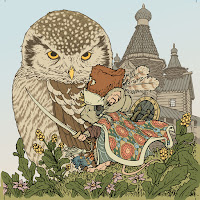Tuesday, May 25, 2021
Usagi Yojimbo Dragon Bellow Cover 2 Process
Tuesday, May 18, 2021
Plotmasters: CLAW
Tuesday, May 11, 2021
The Buck-Toothed Yahbex
Last Friday on my Twitch Stream, we did the fifth community draw-along event #DrawTheExtinct where I posted an image from an old block print I made with a few animal photo inspiration prompts and the idea to create an imaginary extinct animal. I worked on my piece live on my Twitch stream while viewers worked at home and then on Monday we shared our finished pieces.
Here is my finished Buck-Toothed Yahbex. And below are my steps to create it as well as the community submissions.
I told the viewers that they could use any combination of the inspiration prompts––they could make their version as cute and cuddly as a pocket pet stray kitten, as monstrous and deadly as a giant kaiju destroying cities, or anything in between. I also wanted this to be an excuse to get their pencils moving. I invited all skill levels, because I'm a firm believer that you shouldn't have to be good at something or pursuing mastery of it to just simply enjoy the act of it...and art is no exception.
After I'd locked in my above design, I printed that piece out on copy paper and taped it to the back of a sheet of Strathmore 300 series bristol. Using a lightpad, I was able to see through the surface of the bristol as I inked the Buck-Toothed Yahbex. I used a Copic Multiliner 0.7 SP pen to ink the art. I was still streaming this portion on Twitch, though as my end of stream time was coming up, I was nervous I wouldn't finish in time. Turned out, I was able to get the last bits of ibex-style horn inked as I said goodbye to everyone watching and offered encouragement as they worked on theirs over the weekend.
Off stream I scanned the inked artwork into Photoshop to prep it for final color. First thing was to drop it into the template I have for #DrawTheExtinct pieces with the border, background, and a base shadow already established. Then I started drawing in flat colors. This part of coloring (called flatting) is just a professional digital version of coloring-in-the-lines to establish the color areas.
My color choices were somewhat based on the original lino print, but I tried to make the fur closer to a realistic and believable grey rather than blue.
Below you can again see the final rendered corrected colors with a border and type applied.
Tuesday, May 4, 2021
Owlhen Caregiver Cover process
The Diamond order code is MAY210942.
For this blogpost I'll go through the steps and references for creating the cover art you see to the left.




































